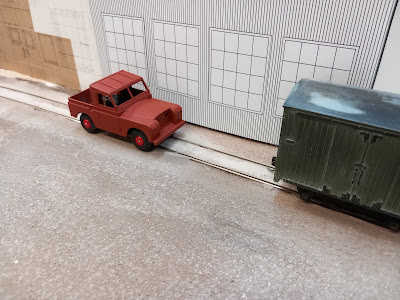Water tank 3D print.
Paint the new stone face under the quarry tipping point.
Apply grass and shrubs to side of engine shed.
Form roof of loading dock building.
Add fixing brackets to hold cottages in place.
Make coal staithe beside engine shed.
Fit loading bay roof frame to building.
Check on water tank 3D print.
Review the motorised Land Rover progress.
After copious research on engine boiler capacities, Geoff had drawn a 3D representation of a cast iron water tank. This had been set printing earlier in the day.
In the workshop, Geoff set about painting the new stone undercroft in the quarry.
He then moved on to adding more electrostatic grass and scrub to the ground beside the engine shed.
Stephen started with the loading dock building roof. A steeper than planned roof sub-base was fitted, probably to be felted, but not confirmed yet. A nice gutter was formed across the roof. Note blocks being fixed to the loading dock roof to make the later fixing more solid.
Anchoring of the cottages was then discussed with aluminium angle pieces at three points being the chosen solution. Second hand point motor mounts were used. Bolt holes were drilled through the angles and baseboard (over the through line), before epoxy glue fixed the angles to the buildings. Short M6 bolts and nuts will hold them down long-term.
Geoff moved onto constructing a coal staithe beside the shed; made from hardwood sawn to sleeper size and glued in place. Ends for the staithes in the same material will follow next week.
Fixing the cottages down will allow the scenery in front to be tackled - path, doorsteps, grass, shrubs etc. The loading bay roof constructed last week was glued and clamped onto the building shell.
Unfortunately, the water tank print failed. It didn't adhere to the grid of support points and resulted in a pile of sludge. Geoff will modify the arrangement and try again.
Stephen had successfully assembled the gearbox and rear axle unit on the Land Rover. Testing at home could only go so far, so a run on the actual layout would show if it worked. As at home, a 5v phone charger power unit was clipped onto the end of the siding rails and the car set down over the track. After cleaning out the rear flangeway slot (where the vehicle guides ran), the car trundled along nicely. After a few stutters, Geoff suggested pick-ups at the rear as well as the front, which will be considered. It now needs a big block of something on the front to house a towing hook, to couple up with Kadee couplings on the wagons.
A very productive day!










